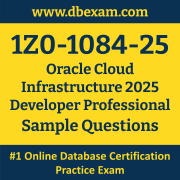01. In Oracle Cloud Infrastructure (OCI) Monitoring, which two metrics are automatically collected and made available by the feature for functions deployed with Oracle Functions?
a) Amount of CPU used by a function
b) Length of time a function runs
c) Number of times a function is invoked
d) Amount of RAM used by a function
02. Which is required before you can push and pull Docker images to and from Oracle Cloud Infrastructure Registry using the Docker CLI?
a) Auth token
b) OCI Vault secret
c) SSH key pair
d) Docker registry secret
03. Suppose you're leading the development of a collaborative document editing platform, where users can create, edit, and share documents in real time. To ensure scalability and flexibility, you decide to architect the platform using microservices.
Which two advantages of microservices would be most beneficial?
a) Shared data store for seamless collaboration
b) Can be independently deployed
c) Ability to communicate over lightweight APIs
d) Require testing across multiple programming languages
e) Are tightly coupled, simplifying inter-service communication
04. Assume that your function does NOT have the --provisioned-concurrency option enabled. Which parameter would you use to configure the time period during which an idle function will remain in memory before Oracle Functions removes its container image from memory?
a) function-timeout
b) idle-timeout
c) container-timeout
d) The time period is not configurable.
05. You are a Cloud Solutions Architect tasked with securing access to an API deployed on Oracle Cloud Infrastructure (OCI) API Gateway for your company's internal services.
Authentication is a critical aspect of this deployment to ensure that only authorized users and applications can access the API.
Which two are valid authentication methods for accessing an OCI API Gateway deployment?
a) SAML Token
b) JSON Web Token (JWT)
c) Oauth
d) API Key
06. In the context of monitoring a cloud-based e-commerce platform, you're configuring event rules in Oracle Cloud Infrastructure (OCI) to trigger actions based on specific events.
Which action type is NOT available in an OCI Events rule definition?
a) Streaming
b) Functions
c) Notifications
d) Email
07. Consider a scenario where you are leading a team tasked with modernizing an e-commerce platform. As part of the modernization process, you are considering adopting containerization technology.
Which two statements are FALSE regarding containers?
a) Containerized applications run on top of a hypervisor that in turn runs on the operating system.
b) Containers are highly reusable.
c) Containers are highly portable.
d) Containers are essentially the same as virtual machines.
e) Containers are scalable.
08. Which is necessary to access an Oracle Cloud Infrastructure (OCI) Container Engine for Kubernetes (OKE) cluster using the kubectl CLI?
a) An SSH key pair with the public key added to the cluster worker nodes
b) A configured OCI API signing key pair
c) Tiller enabled on the OKE cluster
d) OCI Identity and Access Management (IAM) Auth Token
09. You are configuring an Oracle Cloud Infrastructure (OCI) API Gateway to handle requests for your microservices architecture. You need to set up various backend integrations to route incoming requests to appropriate services.
Which two are valid backend-type options that you can choose when configuring your API Gateway Deployment?
a) ORACLE_FUNCTIONS_BACKEND
b) HTTP_BACKEND
c) SMTP_BACKEND
d) ORACLE_BACKEND
e) STOCKS_BACKEND
10. As a Cloud Native developer, you have deployed a new API for your company's services. Your security team has identified the need to protect your API from potential Distributed Denial-of-Service (DDoS) attacks.
You are under a tight deadline and need to implement a solution as quickly as possible. What should you do?
a) Implement a custom firewall solution for your API.
b) Use an on-premises hardware solution to filter traffic.
c) Use the OCI API Gateway service and configure rate limiting.
d) Develop a script to manually monitor and block suspicious IP addresses.
 The Oracle Cloud Infrastructure Developer Professional (1Z0-1084-25) Sample Question Set is designed to help you prepare for the Oracle Cloud Infrastructure 2025 Certified Developer Professional certification exam. To become familiar with the actual Oracle Certification exam environment, we suggest you try our Sample Oracle 1Z0-1084-25 Certification Practice Exam.
The Oracle Cloud Infrastructure Developer Professional (1Z0-1084-25) Sample Question Set is designed to help you prepare for the Oracle Cloud Infrastructure 2025 Certified Developer Professional certification exam. To become familiar with the actual Oracle Certification exam environment, we suggest you try our Sample Oracle 1Z0-1084-25 Certification Practice Exam.